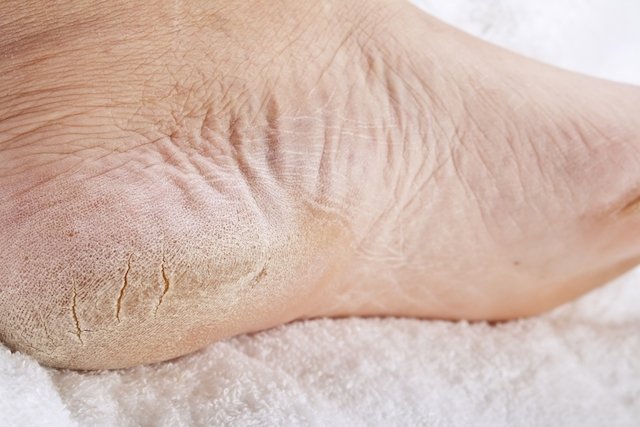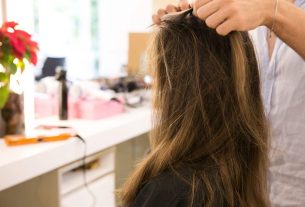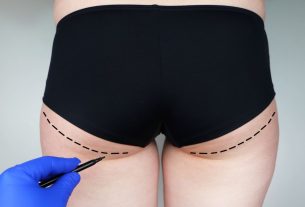Cracked feet appear when the skin is very dry and, therefore, ends up breaking under the weight of the body and the small pressure of day-to-day activities, such as running for the bus or climbing stairs, for example.
Therefore, the best way to prevent cracked skin from appearing on the heels is mainly to keep your feet well hydrated, applying cream at least once a day.
However, for those who already have dry and cracked feet, there is a care ritual that leaves the skin silky and soft again, allowing you to wear sandals and flip-flops without shame.
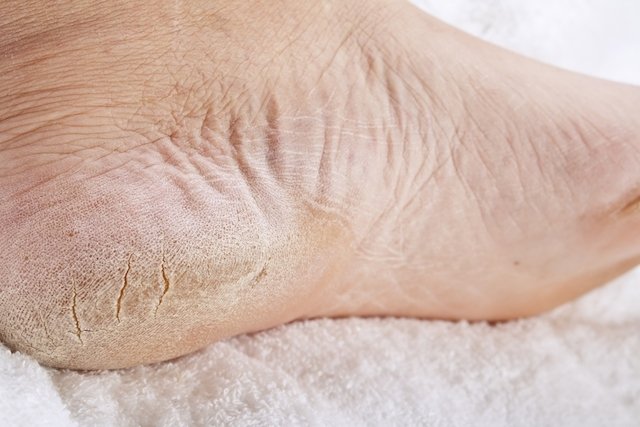
Home treatment for cracked feet
This treatment ritual for cracked feet should be done at least twice a week or every day, during periods when your feet are very dry.
1. Take a moisturizing foot bath
The first step is to take a foot bath, to soften the skin and open the pores, allowing the moisturizing cream to be well absorbed by all layers of the skin.
To do the foot bath you must:
- Place some warm water in a basin until it reaches a height of 8 to 10 cm, or a height that allows the entire foot to be immersed in the water;
- Add 1 to 2 tablespoons of moisturizerdepending on the amount of water;
- Mix the cream well with the waterto dissolve completely;
- Soak your feet for 5 to 10 minutesto ensure that the skin remains soft and absorbs the cream.
Ideally, foot baths should not be done with very hot water, nor without moisturizing cream, as this will open and attack the pores, which can make the skin drier.
2. Dry your feet properly
After finishing the foot bath, it is very important to dry the skin well, to avoid the growth of fungus, especially between the toes. However, you should avoid rubbing the towel on your skin, as this action makes the skin more irritated and contributes to increased dryness.
Therefore, the ideal is to dry the skin with light pressure movements on the skin, to remove excess water, and then leave the feet in the open air for 2 minutes, so that they dry completely.
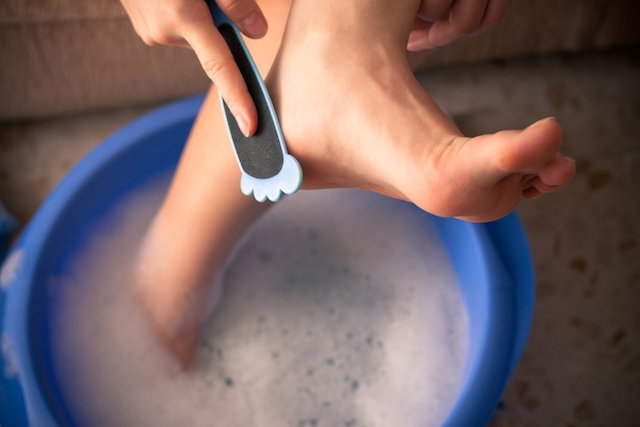
3. Remove excess skin with sandpaper
This step of the ritual is optional and should generally only be done when there are no longer any cracks, but the skin is still thick and dry. In these cases, after drying the foot with a towel, but before leaving it to dry in the open air, you should use a foot file, or a pumice stone, for example, to make light movements on the heel and remove excess dirt. dead skin.
This technique can also be done on other drier areas of the foot, such as the side of the big toe. Afterwards, you can rinse your foot again with warm water, or remove the skin that has come off, using a towel, for example.
4. Apply a moisturizing cream
When the foot is completely dry, apply a little moisturizing cream to close the pores and hydrate the skin. The thicker the cream, the greater the degree of hydration, but the choice can be made according to each person’s preferences.
After applying the cream, you must put on a sock to ensure that it is not removed by your shoes and that it is completely absorbed by the skin. Furthermore, the sock helps the foot not slip, preventing possible falls. A good option is to do the ritual before bed, so that you keep the socks on for a few hours and without the pressure of the shoe.
Check out the video below how to make a great homemade moisturizing cream to save your foot:
Main causes of cracked feet
The main cause of cracked feet is a lack of hydration, which makes the skin less flexible and easier to break. However, there are some factors that contribute to loss of hydration, such as:
- Walking barefoot for a long time;
- Frequently use sandals and flip-flops;
- Being overweight;
- Take a shower with very hot water.
Furthermore, those who do not drink the necessary amount of water during the day also have drier skin and, therefore, are more likely to have quickly dry feet. See how to calculate how much water you should drink per day to ensure a healthier body.
Anyone who has these risk factors should apply moisturizer at least once a day, after bathing or before going to bed, for example, to ensure that the skin is well hydrated and does not run the risk of breaking down during the day. a-day.

Sign up for our newsletter and stay up to date with exclusive news
that can transform your routine!
Warning: Undefined array key "title" in /home/storelat/public_html/wp-content/plugins/link-whisper-premium/templates/frontend/related-posts.php on line 12
Warning: Undefined array key "title_tag" in /home/storelat/public_html/wp-content/plugins/link-whisper-premium/templates/frontend/related-posts.php on line 13

